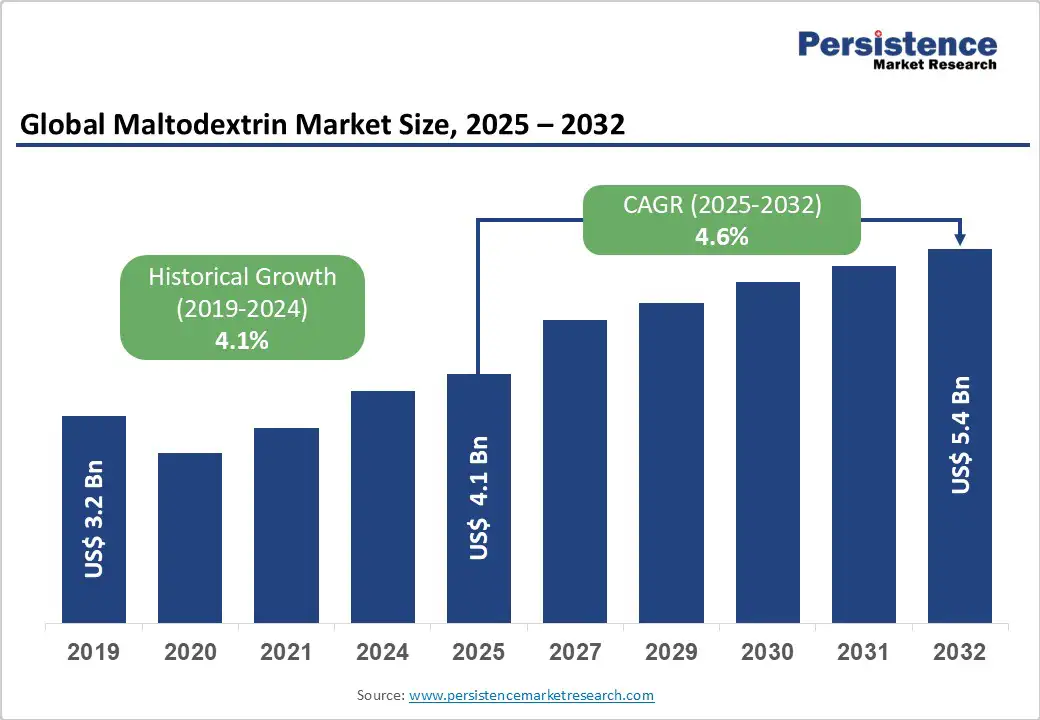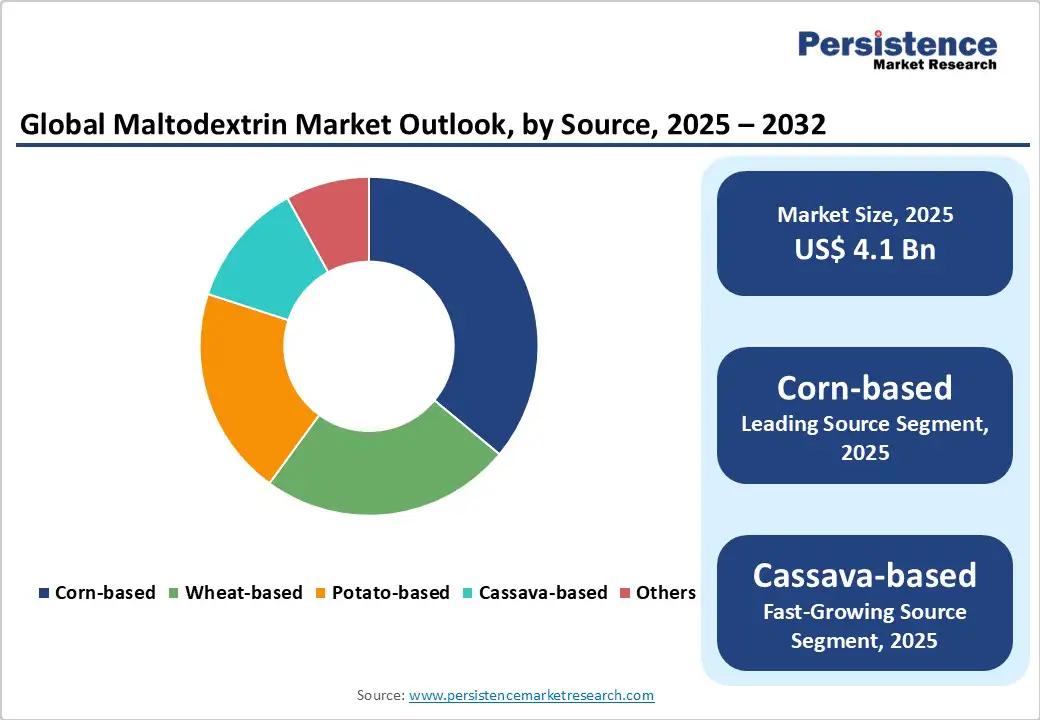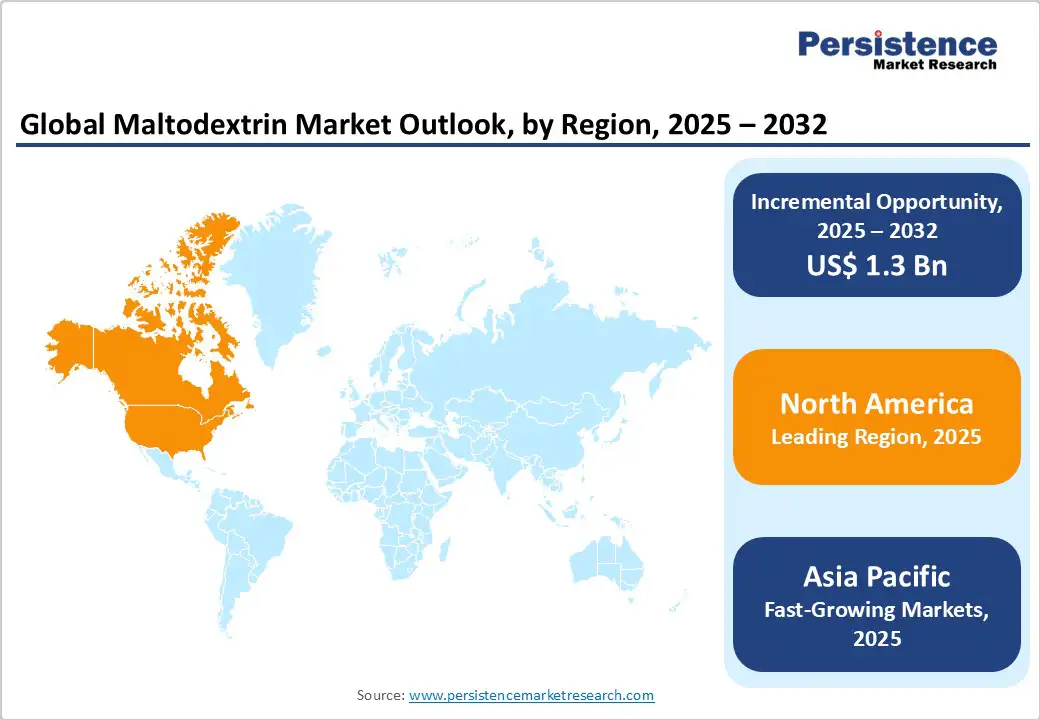ID: PMRREP4439| 189 Pages | 15 Oct 2025 | Format: PDF, Excel, PPT* | Food and Beverages

The global maltodextrin market size is expected to reach US$4.1 billion by 2025. It is projected to reach US$5.4 billion by 2032, growing at a CAGR of 4.6% during the forecast period of 2025 -2032, driven by increasing demand across the food and beverage, pharmaceutical, and sports nutrition sectors.
Key trends include a rising preference for sugar-free and low-calorie products, the expansion of processed and convenience foods, and the growing adoption of functional and fortified formulations.
| Key Insights | Details |
|---|---|
| Maltodextrin Market Size (2025E) | US$ 4.1 Bn |
| Market Value Forecast (2032F) | US$ 5.4 Bn |
| Projected Growth (CAGR 2025 to 2032) | 4.6% |
| Historical Market Growth (CAGR 2019 to 2024) | 4.1% |

The rising demand for downstream products and the growing need for sugar-free alternatives significantly drive the growth of the maltodextrin market. In recent years, maltodextrin has seen increased use in products such as milk powder, ice cream, candies, soft and instant drinks, and various flavorings and essences. Its functional properties, including improving texture, sweetness, and stability, make it a preferred ingredient in many food and beverage applications.
Furthermore, maltodextrin is used in breweries to enhance dryness and head retention, further expanding its application scope. The growing incorporation of maltodextrin across diverse food and beverage products is expected to create substantial sales opportunities in the coming years.
Simultaneously, the global rise in demand for sugar-free foods is driving its adoption, as maltodextrin is not classified as a typical sugar and is considered safe for diabetic patients. This combination of functional versatility and suitability for sugar-free applications is fueling robust market growth.
The maltodextrin market faces a notable restraint due to the rising population of gluten-intolerant individuals worldwide. Celiac disease, an autoimmune disorder triggered by gluten, affects approximately 1.4% of the global population, with biopsy-confirmed cases at about 0.7%. Maltodextrin is often derived from wheat, corn, or other sources of starch, which may pose health concerns for individuals with gluten sensitivity or celiac disease.
As the number of gluten-intolerant consumers increases, a significant portion of the population may avoid products containing maltodextrin, which could limit its adoption in certain food and beverage applications. This trend is expected to restrict market growth opportunities, particularly in regions with higher awareness of gluten-related health issues.
Manufacturers may need to explore alternative gluten-free sources or carefully label their products to address this concern. Consequently, the increasing prevalence of gluten intolerance acts as a critical factor that could slow the expansion of the maltodextrin market in the coming years, influencing product formulation and consumer acceptance strategies.
The maltodextrin market is witnessing significant growth opportunities due to its rising application in sports drinks and various food products. Maltodextrin is widely used in sports nutrition formulations because it provides a quick source of energy, improves endurance, and enhances carbohydrate content without adding excessive sweetness. Athletes and fitness enthusiasts are increasingly opting for maltodextrin-based energy drinks, gels, and powders, driving demand in this segment.
In addition to sports nutrition, maltodextrin is widely used in various food products, including confectionery, bakery items, ice cream, and instant beverages. Its functional properties, including acting as a thickener, stabilizer, and bulking agent, make it a versatile ingredient for improving texture, solubility, and shelf life.
The growing preference for convenient, ready-to-eat, and processed foods further boosts its usage. Moreover, the increasing popularity of functional foods, fortified beverages, and protein-enriched snacks provides additional avenues for maltodextrin application.
The combination of rising consumer health consciousness, demand for energy-boosting products, and expanding processed food consumption is expected to create substantial growth opportunities for the global maltodextrin market in the coming years.
Corn-based maltodextrin is expected to hold a dominant position with around 36.5 % share in 2025 due to the widespread availability of corn, established processing technologies, and its cost-effectiveness.
Corn-derived maltodextrin is extensively used across various food and beverage applications, including confectionery, bakery, dairy, instant drinks, and sports nutrition products, making it the preferred choice for manufacturers. Its functional properties, such as acting as a thickener, stabilizer, and energy source, further support its market leadership.
Cassava-based maltodextrin is emerging as the fastest-growing segment. Cassava offers a gluten-free and sustainable alternative, appealing to health-conscious consumers and regions with high demand for gluten-free products.
Its increasing adoption in confectionery, beverages, and functional foods is driven by rising awareness of gluten intolerance, clean-label preferences, and the need for alternative starch sources. The combination of health trends and sustainable sourcing is expected to fuel significant growth for cassava-based maltodextrin globally.
In terms of applications, the food and beverages segment is expected to dominate the maltodextrin market, accounting for the largest share. Its extensive use in confectionery, dairy, bakery, ice cream, instant drinks, and sports nutrition products has established maltodextrin as a versatile ingredient in this segment.
It is widely utilized as a thickener, filler, stabilizer, and energy source, while also enhancing the texture, taste, and shelf life of food products. The growing demand for convenience foods, processed items, and sugar-free alternatives continues to drive the widespread application across the global food and beverage industries.
On the other hand, the pharmaceuticals segment is likely to be the fastest-growing application area. Maltodextrin is increasingly incorporated into drug formulations as a stabilizer, binder, and excipient due to its favorable safety profile and ease of digestion. The rising demand for effective drug delivery systems and the global expansion of the pharmaceutical sector are driving the growth potential of maltodextrin in this segment.

North America maltodextrin market is characterized by strong growth, driven primarily by the well-established food and beverage industry and high consumer demand for processed and convenience foods. The region benefits from advanced research capabilities, stringent quality standards, and widespread adoption of functional ingredients in food formulation.
Maltodextrin is widely used in products such as confectionery, bakery items, dairy, and beverages due to its versatility as a thickener, stabilizer, and energy source. The increasing demand for sports nutrition and protein-enriched products further contributes to market expansion.
The rising focus on sugar reduction and low-calorie formulations has further enhanced the use of maltodextrin in sugar-free and reduced-sugar products. Strong infrastructure, well-established distribution networks, and increasing investments by leading players in R&D and new product launches support sustained market growth. The market is also benefiting from rising awareness of functional and fortified foods, making North America a dominant region in the global maltodextrin market.
Asia Pacific is predicted to be the fastest-growing regional market, owing to rapid urbanization and an increasing demand for processed and convenience foods. Countries such as China, India, Japan, and South Korea are witnessing high adoption of maltodextrin in confectionery, dairy, bakery, beverages, and sports nutrition products.
The expanding health-conscious consumer base is encouraging the development of sugar-free, low-calorie, and functional food products incorporating maltodextrin.
Furthermore, growth in the sports nutrition and energy drink sectors is fueling its application in energy and carbohydrate-enriched formulations. Government initiatives supporting the food and beverage industry, investments in modern manufacturing facilities, and rising collaborations with international players are contributing to market expansion.
Growing awareness of fortified and functional foods, along with the increasing popularity of on-the-go food options, is also creating significant opportunities for maltodextrin manufacturers.

The global maltodextrin market landscape is highly competitive, with key players focusing on product innovation, capacity expansion, and strategic collaborations to strengthen their market presence.
Leading companies such as Cargill, Ingredion Incorporated, Tate & Lyle, Roquette Frères, and Grain Processing Corporation dominate the landscape through diversified product portfolios and extensive distribution networks. Competitive strategies include mergers and acquisitions, partnerships with food and beverage manufacturers, and investment in research and development to produce specialty maltodextrin for sugar-free, low-calorie, and functional food applications.
Additionally, regional players are increasingly entering the market, intensifying competition and driving innovation to meet growing demand globally.
The global maltodextrin market is projected to be valued at US$ 4.1 billion in 2025.
Growing demand for processed foods, sports nutrition, and confectionery products, along with its versatility as a thickener and sweetener.
The global maltodextrin market is poised to witness a CAGR of 4.6% between 2025 and 2032.
Expansion in clean-label and organic products, rising use of maltodextrin in pharmaceuticals, and increasing demand in emerging food and beverage markets are key market opportunities.
AGRANA Group, The Archer Daniels Midland Company (ADM), Tate and Lyle Plc., and Cargill Incorporated are some key players.
| Report Attribute | Details |
|---|---|
| Historical Data/Actuals | 2019 - 2024 |
| Forecast Period | 2025 - 2032 |
| Market Analysis | Value: US$ Bn and Volume (if Available) |
| Geographical Coverage |
|
| Segmental Coverage |
|
| Competitive Analysis |
|
| Report Highlights |
|
By Source
By Form
By Application
By Region
Delivery Timelines
For more information on this report and its delivery timelines please get in touch with our sales team.
About Author